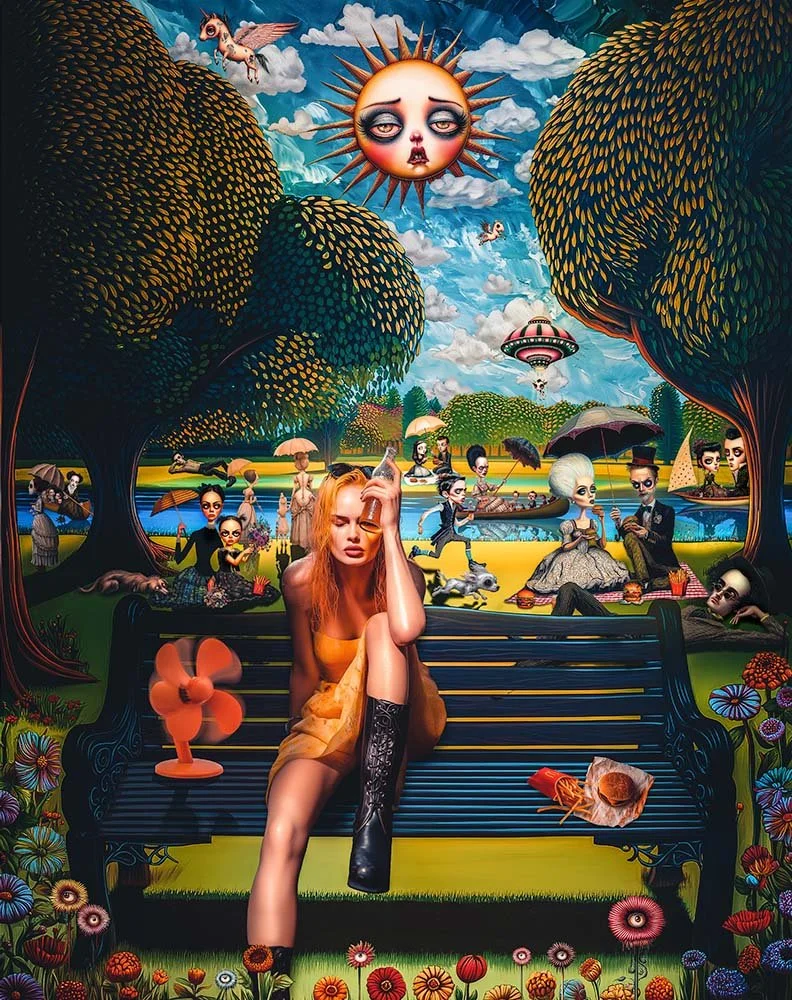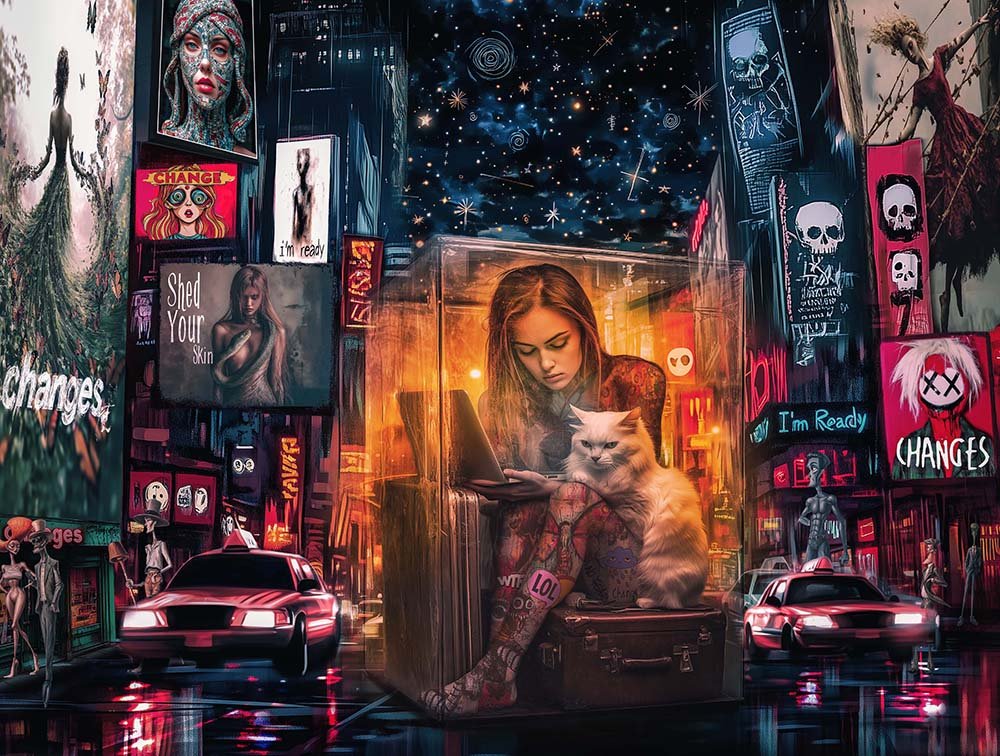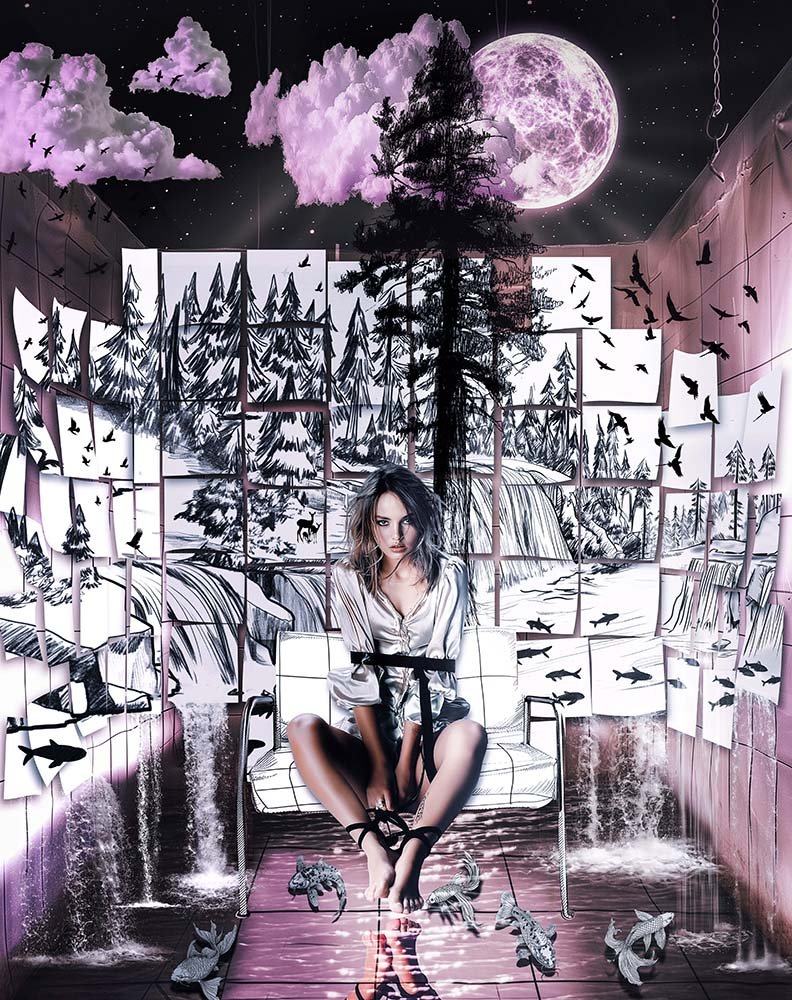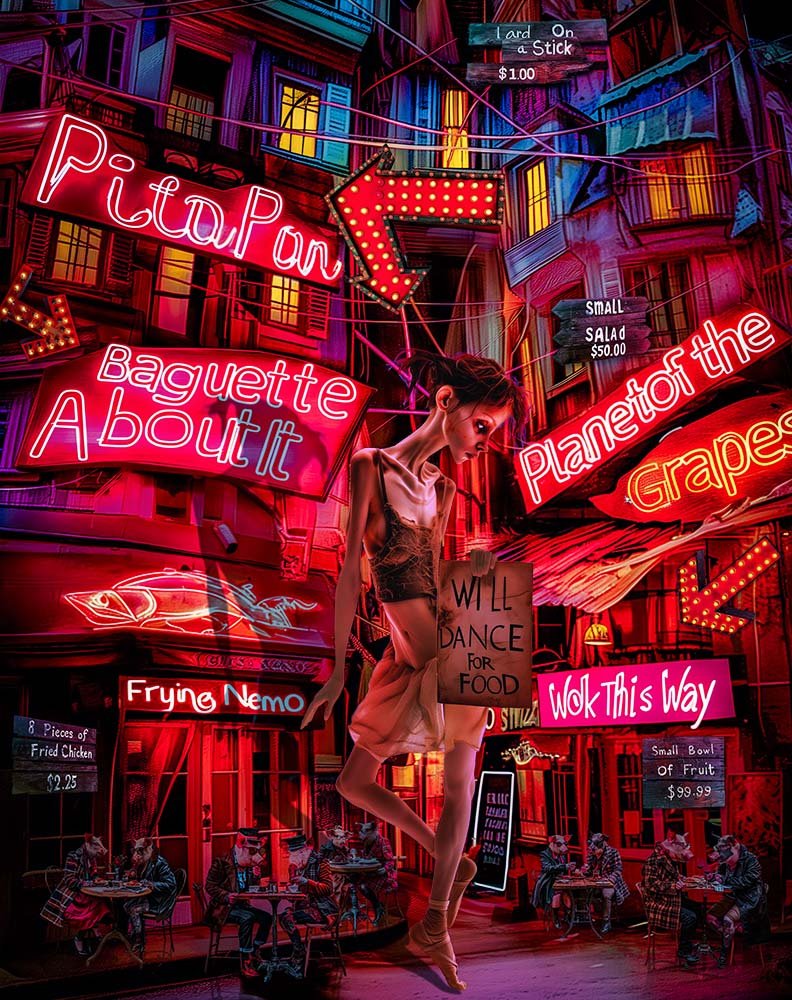Echoes of Funland - SOLD

“Echoes of Funland” is a surreal reflection of a childhood memory that lingers like a half-forgotten dream - a traveling carnival I visited at eight years old, a place where wonder curdled into fear. Under the neon glow of a crescent moon, the fair seemed alive with magic: the Ferris wheel spun like a portal to the stars, carousel horses pranced in endless circles, and music drifted through the air like whispers from another world. But beneath the flashing lights and painted smiles, something felt off. The rides groaned with age, carnival prizes were tattered and forgotten, and laughter had an eerie, hollow ring.
Then, in a single moment, wonder turned to terror - I lost sight of my family. The crowd became a sea of unfamiliar faces, the dazzling lights blurred into disorienting streaks, and the cheerful music twisted into an unsettling tune. I wandered through the fair clutching a broken doll I’d won, its limp form the only thing anchoring me to reality. Every joyful sight now felt sinister - the spinning Ferris wheel loomed like an unblinking eye, the carousel’s painted horses grinned too wide, and the Funland sign flickered like a cruel joke. The carnival, once a playground of dreams, had transformed into a nightmare I couldn’t escape.
In this piece, the girl on the cracked rocking horse is me, frozen in that moment of realization. Her hollow eyes reflect the fear and isolation I felt, surrounded by discarded, broken toys - symbols of childhood promises that crumbled to dust. Above her, the “Funland” sign drips with neon irony, its artificial glow a mocking contrast to the decay below. The Ferris wheel, still spinning, represents the endless cycle of nostalgia, its red lights bleeding into the darkness like an open wound. A lone piano player atop the pile plays a ghostly melody, her notes unraveling into memory, lost in time. Glowing robots and eerie dolls litter the scene, scattered remnants of my imagination trying to make sense of the chaos - each one a fragment from the countless AI-generated images I layered in Photoshop to reconstruct that fractured night.
A cyborg woman with exposed robotic parts stands on a fire escape. Her stance carries attitude but also exhaustion. She knows the irony of those TOUCH GRASS billboards, leering like evangelical hookers promising salvation for three easy payments of your soul. She gets the joke - hell, she’s the punchline. Touch grass is the new absolution: pay for the app, subscribe to social media, redeem your soul in micro-transactions. Teal light against dull concrete traps the scene in cinematic weight, balancing beauty and confinement.
I can’t stand summer. It rolls in like a grim reaper with a tan, swinging humidity and sunshine like a meat cleaver. The air turns thick, sticky - like breathing through a mold-rotted rag - and suddenly everyone’s joined a cult of sun worshippers, chanting the gospel of “good vibes” under that leering, golden stare.
Neon Diaries is a visual metaphor - every artwork I create is born from a personal story, much like ink spilled in a private journal. But unlike hidden pages, my art lays bare my deepest thoughts for all to see. In Neon Diaries, she is surrounded by floating electric monitors. Each glowing screen reveals a distinct futuristic journal entry - a metaphor for the way all my artwork tells stories. And this piece, in particular, explains how I came to that style of creating.
Broken ≠ Worthless is a raw, surreal tribute to the discarded and misunderstood - both people and things - woven from personal grief, fractured memories, and the quiet resilience of unexpected connection. It traces a journey from childhood love and loss to adult abandonment and isolation, where even a beloved collie becomes a casualty of life's unraveling. In the quiet wreckage, a bond forms with a wary street dog, slowly rebuilding trust and revealing that even the most shattered souls still crave - and deserve - love. The accompanying artwork crowns this truth in defiance: a figure seated in sovereignty over her chaos, flanked by symbols of loyalty and pain, declaring that what society calls trash can still blaze with meaning.
Patience is the art of hoping. - Luc de Clapiers
‘Patience’ is a deeply symbolic piece that reflects my personal journey as an artist and the resilience required to endure life's uncertainties. At its heart is a woman seated at a rusted piano, overgrown with vines and worn by time—a powerful metaphor for the passage of years and the patience needed to create something meaningful. The woman herself is not untouched by time; rust and vines creep across her form, merging her with her surroundings and underscoring the transformative effects of persistence and struggle.
“Echoes of Funland” is a surreal reflection of a childhood memory that lingers like a half-forgotten dream - a traveling carnival I visited at eight years old, a place where wonder curdled into fear. Under the neon glow of a crescent moon, the fair seemed alive with magic: the Ferris wheel spun like a portal to the stars, carousel horses pranced in endless circles, and music drifted through the air like whispers from another world. But beneath the flashing lights and painted smiles, something felt off. The rides groaned with age, carnival prizes were tattered and forgotten, and laughter had an eerie, hollow ring.
Step into Satirical Inferno, where childhood innocence collides with the chaos of adulthood. Created by Surreal24seven, this piece features a large woman made from paper mache at its center. Her intense gaze pulls us into the narrative of transformation, as behind her, childhood icons like Mickey Mouse, Minnie Mouse, and Donald Duck are depicted in stark white—stripped of their usual colors. These familiar characters now engage in adult behaviors: Donald smoking weed, Minnie and Mickey drinking, surrounded by cash and guns. The contrast highlights how childhood ideals are reshaped by the adult world.
‘Never Forgotten’ is a profoundly personal artwork that captures the enduring bond between a mother and child, transcending the boundaries of life and death. Inspired by Mary Elizabeth Frye’s poignant poem ‘Do Not Stand at My Grave and Weep,’ this piece explores themes of loss, memory, and spiritual connection, offering a heartfelt reminder that love endures beyond the physical world.
The artwork depicts a woman sitting alone on a serene beach, accompanied by an empty chair—a poignant symbol of the loved one she has lost. Surrounding her are ethereal silhouettes of angels, their presence representing the unseen forces that guide and comfort us in times of grief. Above the clouds, heaven is visible, serving as a beacon of hope and the ultimate reunion beyond this life.
"Shed Your Skin" is a profound visual narrative of transformation, growth, and resilience, capturing the essence of beauty that arises from embracing change. The central figure, a woman covered with tattoos of butterflies and caterpillars, embodies the journey from burden to liberation. These tattoos transcend mere decoration; they are narratives etched into her skin, chronicling her past struggles and triumphs as she evolves.
At first glance, this piece feels chaotic, surreal, cartoonish – but like a memory, it’s layered. This is a story about a memory – about the ghosts we’re told to bury becoming the ones who shape us. A quiet opera for the emotionally maimed.
‘The Gift of Imagination’ delves into the interplay between perception, creativity, and reality, inviting viewers to explore the power of the mind to transcend even the harshest circumstances. This artwork unfolds across three distinct layers, each representing a facet of the woman’s experience.
The purple elements symbolize her subjective reality, where a surreal sky illuminates her world, offering a glimpse into her unique perspective. This dreamlike atmosphere reveals the depth of her mind’s eye—a realm where imagination flourishes beyond physical limitations.
"Changes" – This artwork captures the essence of personal transformation through the intimate connection we share with music. When I was 20, "Miss Misery" by Elliott Smith was the song that marked a pivotal shift in my life. I remember hearing it in a small, intimate venue, the raw emotion in Smith's voice resonating with my own feelings of uncertainty and longing for something more. It was then I decided to move to Los Angeles, drawn by the dream of becoming an actor. The song's melancholy melody seemed to echo through the vibrant, sunlit cityscape behind the violinist in "Changes," each note pushing me towards a life filled with auditions, dreams, and endless possibilities.
‘Will Dance For Food’ is a poignant 1/1 artwork that delves into the themes of hunger, inequality, and the stark disconnect between privilege and need. The title, an ironic plea for sustenance, underscores the desperation faced by those whose basic needs go unmet, contrasting the frivolity of abundance with the harsh realities of deprivation.
This piece is deeply personal, inspired by my time working at a hostel in Guatemala, where I earned just $2 per hour. Guests would often leave behind delicious food, yet I witnessed a striking inequality: two individuals were tasked with distributing leftovers, but they never offered any to me, despite my clear need. Even humorously hinting at my hunger was met with indifference. This experience became a visceral reminder of the disparity between those with excess and those who suffer in silence.













No one looks up from their phone anymore. We live inside our screens until something finally snaps us out of them. In the artwork, that “something” is a surreal woman dropping small glowing orbs from the sky, giving a gentle cosmic shove that forces a couple to glance up at the same moment and actually see each other. It’s a love letter and a warning wrapped into one.